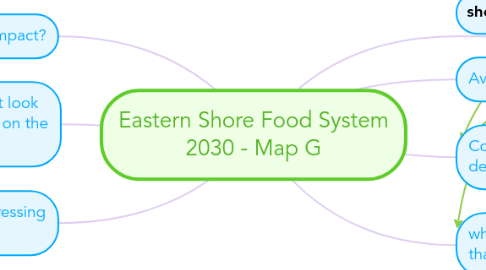
1. What is the economic impact?
1.1. what is the economic viability tipping point large/mono vs small/diverse
1.1.1. we have space for all types and sizes of farms
1.1.1.1. community gardens for 'poor' should be provided
1.1.1.1.1. by who?
1.1.1.1.2. funding? who oversees garden?
1.1.1.1.3. the "poor" are often in unsafe/contaminated areas. Access to safe soil?
1.1.1.2. yes-small, medium, and large!
1.1.2. DIVERSIFICATIN OF FARMS, ACCESS, AND MARKETS
1.2. how is it measured from the regional benchmark?
1.2.1. increase in viable farms, decrease in "lifestyle" disease, decrease in env. cost, increase in food security
1.2.1.1. what info/data is needed to achieve this? who are the key participants of change?
1.2.1.1.1. farmers, anti-hunger groups, economic development measurments over time
1.2.1.1.2. change is ONLY possible with hands on education to all
1.2.2. DATA AND GOAL SETTING
1.3. lower cost for transportation with strong local farming
1.3.1. farming is strong. AG is Md's number one industry. We need to keep farming on the shore strong. Work with farmers to keep food local.
1.3.1.1. make sure they have access to profitable local wholesale markets
1.3.1.1.1. how is food transported?
1.3.1.2. farm markets grow and expand
1.3.1.3. how do we define local?
1.3.1.3.1. just delmarva?
1.3.1.3.2. regional what we can grow to sustain our populations within our own communities. work towards "hyper-local"
1.3.2. is there a way to transport using the bay in a healthy environmentally friendly way?
1.3.3. TRANSPORTATION AND LOCALITY
2. crop diversification - what does it look like? can it feed the food system on the shore?
2.1. employment?
2.2. will we grow specialized produce for wholesale markets or diverse produce for direct, or both?
2.2.1. less monocropping more diversified food
2.2.2. Basic nutritional foods not generally eaten should be encouraged
2.2.2.1. economically penalized
2.2.2.1.1. Not if people learn to grow some of their own food. there is tons of info available from government agencies and online. the smallest spaces can produce if we work with nature rather than against it using chemicals
2.2.2.2. education about growing food based on the region we live in
2.2.2.3. basic nutritional foods should be given production preference over feed/fuel crops
2.2.2.3.1. is that an upstream issue?
2.2.2.3.2. use of chemicals need to be reduced
2.2.3. brand development/marketing
2.2.3.1. vibrant food tourism/economic indication
2.3. must continue to change as science changes. New techniques to grow on less land/space because land disappears unfortunately
2.3.1. do our students have the STEM skills they need to answer this?
2.4. oyster cultures
2.5. FARMING EDUCATION
3. Hunger is no longer a pressing issue on the shore
3.1. that would be wonderful. How do we get there!
3.1.1. education about growing our own food in rural communities again
3.1.1.1. has to involve individual family education on focus over many years
3.1.1.1.1. teaching AG science effectvely
3.1.1.1.2. communities not government are accountable for educational affectiveness
3.1.1.1.3. families are constrained by the options available to them
3.2. multimedia for food access points by zip
3.2.1. MD foodbank has this but it only lists our partnering agencies - not what others are doing. need one place for what everyone is doing?
3.3. HUNGER /FOOD ACCESS
4. shore and bay health
5. Average farmer age then
5.1. farm education focuse more on sustainability and bay impact because future generations will need a place to farm
5.1.1. OPEN SPACE
5.1.1.1. land projuvenation funds
5.2. we have successful, booming new farmer training - for young and older
5.2.1. wish or reality?
5.2.1.1. wish
5.2.2. does it provide an income for farmers
5.2.2.1. and workers in the field to feed their families
5.2.2.2. "successful" includes sustainable economic models too
5.3. New Farmers
6. Concern; what will be grown in depleted soils?
6.1. Soils can be fixed in relatively short time with natural practices; it is being done now
6.1.1. cover crops
6.2. farmers work to maintain and improve soil health everyday/year/season. they want it better for the next generation
6.2.1. what education do farmers need to improve soil health and maintain it?
6.2.1.1. who teaches them?
6.2.1.1.1. lots of info online
6.2.1.1.2. college, comm. college, extension?
6.2.1.1.3. meaningful integration in curiculum
6.2.1.2. SARE has a program to train farmers on soil health
6.3. will health of bay be a factor?
6.3.1. will always be a factor
6.3.2. rising tides
6.3.3. too many people and save the bay
6.3.3.1. need new models for managing large populations in env. sensitive areas
6.3.4. do we have the time to understand phosphorus moving through ground water
6.4. because we know cover cropping is important to soil health
6.4.1. POPULAR EDUCATION
6.4.2. value added foods, fermented, canned- need education
6.4.2.1. look at healing foods not yet grown but possible
6.4.2.1.1. some cover crops like daikon radish are highly nutritional
7. what does age group mean in that year?
7.1. how will age impact access
7.2. capitalize or use of technological innovation
7.3. success or planning
7.4. have we built up enough new farmers in the region to have enough food to feed the shore?
7.4.1. diversity of approach and experience
7.4.2. each of us should be growing some of our own food. it can be done even in pots! stop planting "ornamental" landscaping and replace with food plants/trees
7.4.2.1. good point
